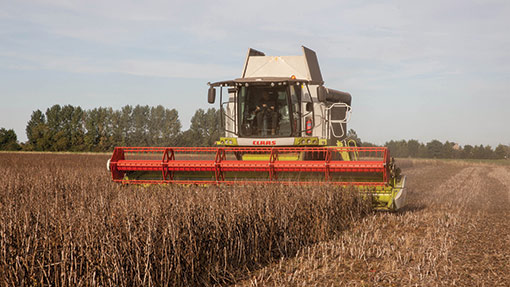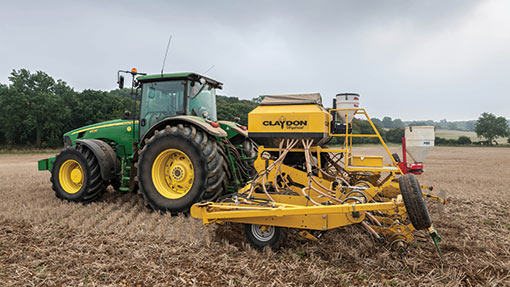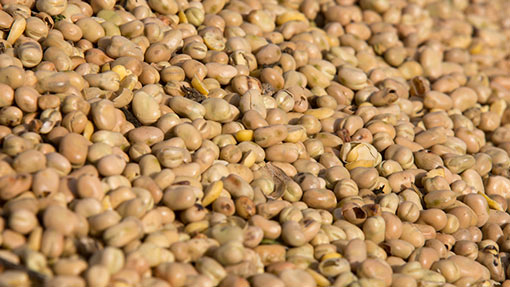Growers reveal secret to profitable winter beans

This autumn may well see a surge in the winter beans as growers look to meet new CAP greening legislation.
But with variety choice, acreage, expected yields – and premiums – to consider what’s the best way to plan for a successful crop?
Luke Casswell spoke to three growers to find out how to turn the rules into profit.
Ensuring winter bean crops make the highest possible premium will require good early establishment and an effective pest-control strategy.
Suffolk grower David Johnson has adapted his winter bean establishment approach over recent years in order to increase yields and overcome new challenges.
On his 30ha of bean land, based about 10 miles east of Bury St Edmunds in Hunston, Mr Johnson has opted for higher seed rates and an earlier drilling date while putting increased emphasis on bruchid beetle control in order to get the optimum price.
He has also begun to use more fungicides, with about four applications to control chocolate spot and mildew in particular.
Farm facts
- Farmed area 800ha (mixture of contract and owned)
- Cropping Winter wheat, sugar beet, winter beans, oilseed rape
- Soils Heavy clays to light loams
- Machinery Tractor – Massey Ferguson 7624; combine – Massey Ferguson Rotary; sprayer – John Deere 5430i; handler – Cat 765d; drill – Sulky; frontline cultivators – Sumo Quatro, 7 furrow plough
And it appears to have paid off. Previous crops of Wizard have generated the same gross margin as his winter wheat, following a yield of more than 5t/ha.
“We’ve had some fantastic crops over the years with average yields of about 4-4.5t/ha. It is not an easy crop to grow, though, despite having fewer inputs than oilseed rape and wheat.”
This season he is trying one of the newer varieties on the Recommended List, Honey, which is also looking promising and will hopefully make seed grade.
A reduction in spray choices over the years has increased the pressure on beans from weeds, but Mr Johnson countered it by increasing last autumn’s seed rate to 31 seeds/sq m.
“Some might say it is a bit heavy, and we may cut it back a bit next year, but we want to use the crop to suppress the weeds because the herbicide options are fairly limited.”
Establishment
Last year’s introduction of a Claydon drill (pictured) has made a big difference, ensuring all the seed was evenly buried.
“Every seed grew, which will have been partly down to the season but also the fact they were at a good depth, well covered and the ground was nice and level.”

His establishment method has varied over the years as he looked to optimise yields. Previously the bean seeds were scattered on and ploughed in and he also trialled a subsoiler system before settling on the Claydon this year.
“We first moved the ground about with a Sumo Quatro and then we went in with the Claydon before rolling it.”
The thickness of the crop this year has helped suppress blackgrass, which Mr Johnson admits can be a particular issue in winter beans.
“If you can get them established well then weeds aren’t usually a big problem. This year we are maybe slightly too thick, but it looks a healthy crop.”
Future role
Winter beans will continue to perform a vital role on Lodge Farm, acting as a profitable break crop, with another 30ha expected to be sown again this autumn.
Merchants have reassured growers there should be enough seed to meet demand and Mr Johnson hopes to have his seed on farm by the end of September, ready for drilling early in October.
“It is still viable to put it in over a cereal in certain situations and there are advantages across the rotation from having a pulse crop.
“To continue to see these benefits we’ve started growing oilseed rape in areas we haven’t had it for a few years, which will allow us to extend the gap between the beans and use different chemistry.”
Making the grade
 In Leiston, Suffolk, 20 miles northeast of Ipswich, Amy Readhead has been growing winter beans for more than 15 years on her 1,000ha family farm.
In Leiston, Suffolk, 20 miles northeast of Ipswich, Amy Readhead has been growing winter beans for more than 15 years on her 1,000ha family farm.
Based on a mix of light and heavy clay soils, the pulse crop has played an important part of the rotation, providing a low-input alternative that gives a good entry into first wheat.
More than 10% of the total acreage on the farm is taken up by winter beans, with 100-150ha being planted each season as part of a one-in-five-year rotation.
“It has always proved a crucial break crop for us, reducing cereal pests and diseases and offering an opportunity to control grassweeds. The majority of the time we have been able to make it profitable as well,” says Mrs Readhead.
However, while it offers the opportunity for lower inputs, careful pest management is vital in order to make it a success and achieve higher prices.
Farm facts
- Farmed area 1,000ha
- Cropping Wheat rape, barley beans and sugar beet
- Soils Heavy clays through to light sand
- Machinery Tractors – Challenger MT765D, New Holland T8050, New Holland T8020; combine – Claas Lexion 760 TT; sprayer – Bateman RB26; drill – Vaderstadt Rapide 600; frontline cultivator – Simba SLD420
“The premiums you can get on beans that go for human consumption are fairly significant and something you should really aim for.”
Bruchid beetle provides one of the main threats to the premium, with significantly increased activity in recent seasons. Mrs Redhead opts for a two-spray programme, going in when the beans develop their first pods and as soon as adult beetles can be found on the crop.A second spray follows seven to 10 days later.
Severe beetle attacks can cause crops destined for human consumption, export or seed to be rejected, so effective control is paramount. The past five years have seen all the winter beans on the farm go for human consumption – but even if they fail, there are still a number of profitable opportunities.
“It’s not the highest earner on the farm, but growers must look at the bigger picture with one of the greatest benefits this year obviously meaning it will ensure new greening rules are met.”
Yields have fluctuated over the years, but optimising early growth will help ensure crops are able to reach their potential, according to Mrs Readhead. In 2012 they peaked at more than 5t/ha, however she admits in more challenging years this is harder to achieve.
Variety choice is an important factor. Pale-skinned, high-yielding Wizard is the bean of choice at House Farm, offering good protein as well as being a favourite for the human consumption market.
She takes advantage of a later drilling date than most crops, with more opportunities to spray off problematic weeds such as blackgrass.
Drilling takes place mid-October using an Amazone Profis Ultra spreader at a seed rate of approximately 220kg/ha. Mrs Readhead then ploughs the seed in to approximately 12.5cm before power harrowing.
“Spinning beans on and ploughing them in allows us to go on when it is slightly wetter and reduces the need for specialist equipment. In drier conditions we subsoil prior to power harrowing.”
Newcomer goes direct
 Lincolnshire grower Matthew Neesham introduced winter beans into his rotation for the first time ever last autumn as he went in search of a break crop that could widen his rotation and offer healthy margins.
Lincolnshire grower Matthew Neesham introduced winter beans into his rotation for the first time ever last autumn as he went in search of a break crop that could widen his rotation and offer healthy margins.
Based close to the city of Lincoln, on heathland, Mr Neesham direct-drilled 70ha of winter beans mid-November using a Dale Eco Drill, following a spring barley crop.
Having implemented zero-till drilling across the farm, it fitted with the controlled traffic system that he has adopted. It also makes winter beans an even lower input crop, with savings on fuel and labour.
Farm facts
- Farmed area 685ha
- Cropping Wheat, barley, oilseed rape, winter beans
- Soils Limestone brash and heavy clay loams
- Machinery Tractors – JD 8345R, JD 6210R, JD 7530; combine – JD S690i; sprayer – JD 5430 self-propelled – all RTK-guided for controlled traffic system
The seed was drilled at about 5cm straight into the barley stubble and established well without suffering too much from disease or weed problems.
“We’ve got a few small pockets of blackgrass but following a fairly standard spray programme the crop is looking quite clean,” says Mr Neesham.
Having tried other break crops such as linseed, he says he has been impressed with the low-maintenance crop, which looks set to achieve a decent yield.
“The following wheat crop will benefit from going in after beans and hopefully we will get a good clean seed-bed to direct drill into again.
“If they do 5t/ha they will be a decent paying crop and will look good against wheat and rape going on current prices.”
Beans demand a premium – for now
There will be strong demand for winter beans next year as the acreage looks set to increase, but prices are expected to dip, according to Andy Bury, national pulse trader with agricultural merchant Frontier.

Harvest 2014 has seen the price of beans receive a £70 premium over feed wheat, but next season Mr Bury expects this to lower to a
£30-40/t premium over feed wheat.
“The important thing to remember is that at this lower price level they become more readily available to people.”
Export standards
Quality standards for export to the Middle East for human consumption are high.
Varieties with a smooth and pale skin and pale hilum are suitable for this market, and it is important that samples are clean, sound and have low levels of bruchid beetle damage.
Beans for compounding for animal feed must be free from moulds.
Domestic consumption of beans by UK feed compounders will increase as beans start to price themselves them into pig and cattle rations and the export of feed beans will increase into southern Spain and southern Italy, says Mr Bury.
There will also be continued demand from North Africa, where UK beans go for human consumption. “Making the most of this market will be important because there is the opportunity to sell into a premium market which, if you fail, loses a potential premium of £10-40/t.”
Growers must also look at the wider picture, with winter beans providing a much cheaper crop to grow than its cereal and rape counterparts.
“Despite the lower premiums it is still a low-input, nitrogen-fixing crop, which will give the equivalent of 0.5t/ha in the subsequent wheat crop,” he explains.

